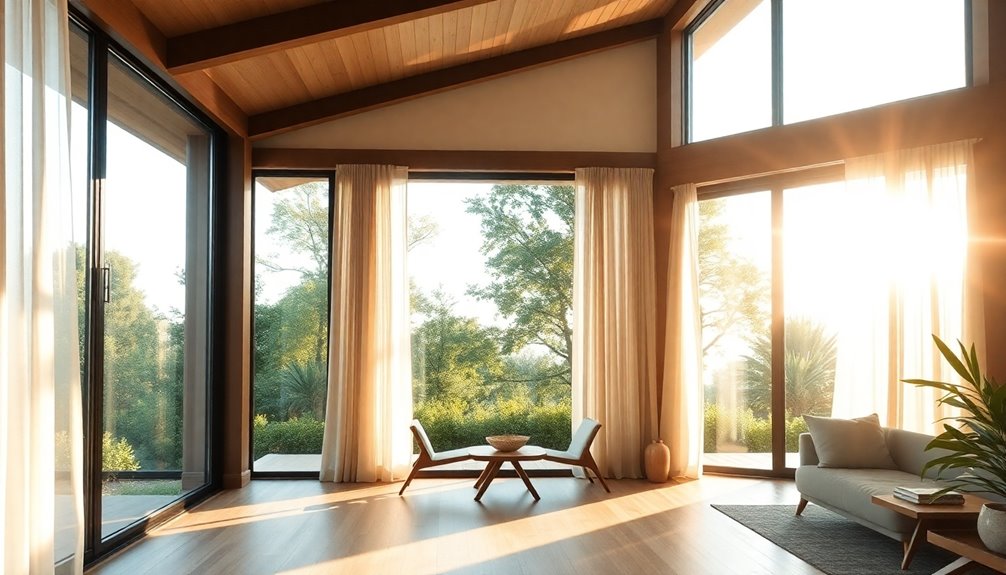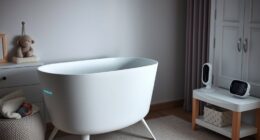Cross-ventilation plays an essential role in energy-efficient home design by enhancing natural airflow, reducing reliance on air conditioning, and improving indoor air quality. By strategically placing openings to harness wind pressure, you can achieve significant energy savings of 20%-40%. This design approach creates a healthier living environment by circulating fresh air, which also lowers indoor temperatures. Discover more about the architectural features and innovations that can maximize the benefits of cross-ventilation in your home.
Key Takeaways
- Cross-ventilation enhances indoor air quality by circulating fresh air, reducing allergens, and improving overall health.
- It decreases reliance on air conditioning, leading to energy savings of 20%-40%.
- Effective cross-ventilation requires strategic placement of openings to capture natural wind flow.
- Incorporating smart building technologies allows for real-time adjustments to optimize airflow and energy efficiency.
- Sustainable home design benefits from cross-ventilation, minimizing carbon emissions and supporting green building certifications.
Understanding Cross-Ventilation

Understanding cross-ventilation is essential for creating a comfortable and energy-efficient home. By utilizing effective cross ventilation strategies, you can enhance natural ventilation systems that promote ideal air flow.
This involves strategically placing windows and vents to create pathways for cool air to enter and warm air to exit, greatly improving indoor air quality. In narrow buildings aligned with prevailing wind directions, these systems maximize airflow, reducing reliance on mechanical cooling.
In Mediterranean climates, for instance, cross-ventilation can lower indoor temperatures by approximately 1.5 °C, proving its effectiveness in thermal comfort and energy savings. Additionally, incorporating wood-burning stoves into your heating strategy can complement cross-ventilation by providing effective radiant heat while enhancing indoor ambiance.
Ultimately, thoughtful building design incorporates these principles to guarantee that ventilation offers not just comfort, but also sustainability in your living space.
Importance of Cross-Ventilation in Home Design

Cross-ventilation plays an essential role in home design, as it not only enhances comfort but also promotes a healthier living environment. By effectively circulating fresh air, you can improve indoor air quality and reduce stale air, which is vital for your well-being. This natural cooling method decreases your reliance on air conditioning, leading to energy savings of 20%-40%. Plus, with thoughtful architectural design, cross-ventilation enhances thermal comfort, keeping your home hospitable and reducing heat-related risks. Implementing quality assurance practices in home design can further optimize energy efficiency and sustainability.
| Benefits | Impact on Comfort | Energy Efficiency |
|---|---|---|
| Improved Air Quality | Enhanced Thermal Comfort | Up to 25% energy savings |
| Reduced Indoor Pollutants | Healthier Living Space | Sustainable Design |
| Natural Cooling | Less Stale Air | Lower Carbon Footprint |
Mechanisms of Cross-Ventilation
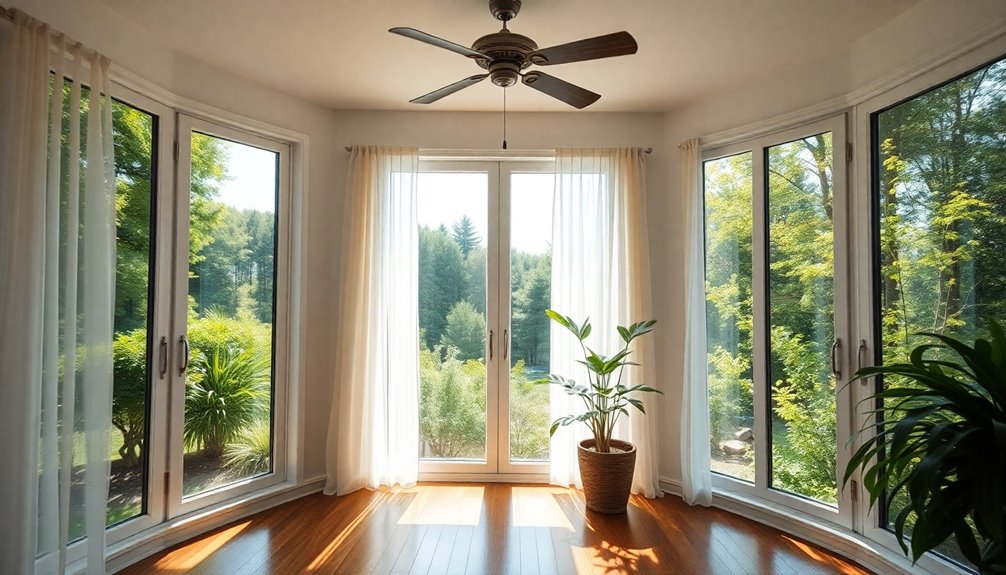
Cross ventilation works by utilizing pressure differentials created by wind, allowing cooler air to enter through strategically placed openings while warmer air exits from others. This air movement enhances indoor airflow and helps maintain comfortable temperatures.
To achieve effective natural ventilation, you need at least two openings positioned based on wind direction and speed. These factors are important in determining the best layout for maximum airflow.
Compared to single-sided ventilation, cross-ventilation considerably improves indoor air quality and thermal comfort, contributing to overall building energy efficiency. In climates like the Mediterranean, it can even lower indoor temperatures by approximately 1.5 °C, highlighting its effectiveness. Additionally, incorporating weather-resistant materials in home design can further enhance the effectiveness of cross-ventilation strategies.
Benefits of Cross-Ventilation for Homeowners

Because of its numerous advantages, cross-ventilation is a game changer for homeowners looking to enhance their living spaces. By effectively circulating fresh air, it can reduce indoor temperatures by up to 1.5 °C, allowing you to feel comfortable without heavily relying on mechanical cooling systems.
This not only improves indoor air quality by reducing allergens and pollutants but also promotes better health for everyone in your home. You’ll likely see significant savings on energy bills, with potential cuts of 20%-40% in energy consumption. Moreover, implementing cross-ventilation can complement heat pump systems, further enhancing overall energy efficiency in your home.
Plus, cross-ventilation supports sustainability efforts by minimizing carbon emissions associated with cooling. With minimal maintenance needs, it’s an energy-efficient solution that offers long-term benefits for homeowners seeking comfort and savings.
Key Architectural Features for Effective Cross-Ventilation
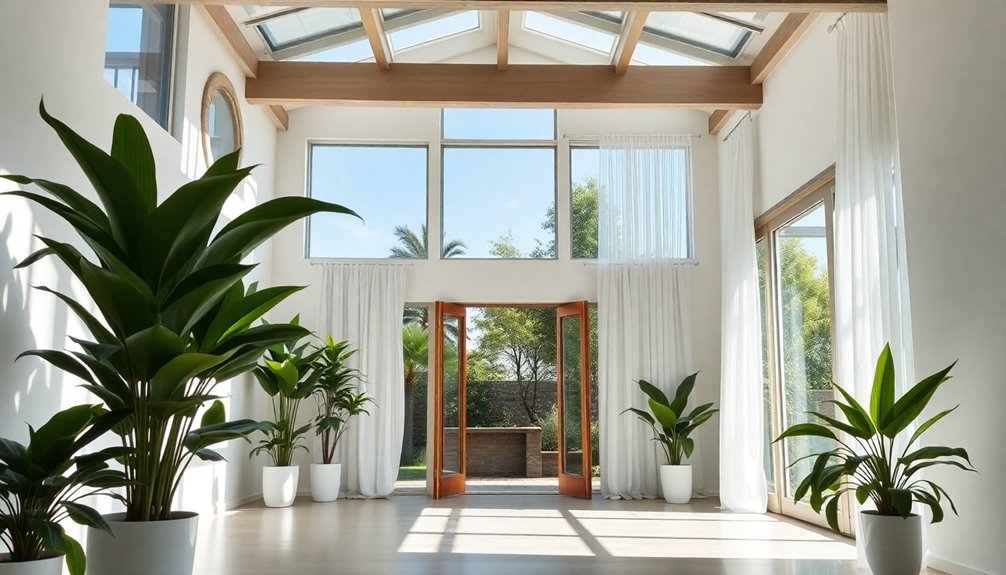
To achieve effective cross-ventilation in your home, it’s important to strategically place openings like windows and vents.
Here are some key architectural features to evaluate:
- Narrow Building Design: A narrower structure captures natural wind more effectively, enhancing airflow.
- Clear Pathways: Keep spaces free from obstructions like large furniture to maintain airflow and support cross ventilation.
- Adjustable Louvers: Integrate architectural elements such as louvers to control air entry while managing rain and sunlight.
- Open Interior Layouts: Design open spaces to promote better airflow dynamics throughout the home. Additionally, incorporating natural materials like wood can further enhance the overall aesthetic and comfort of the living environment.
Strategies for Implementing Cross-Ventilation
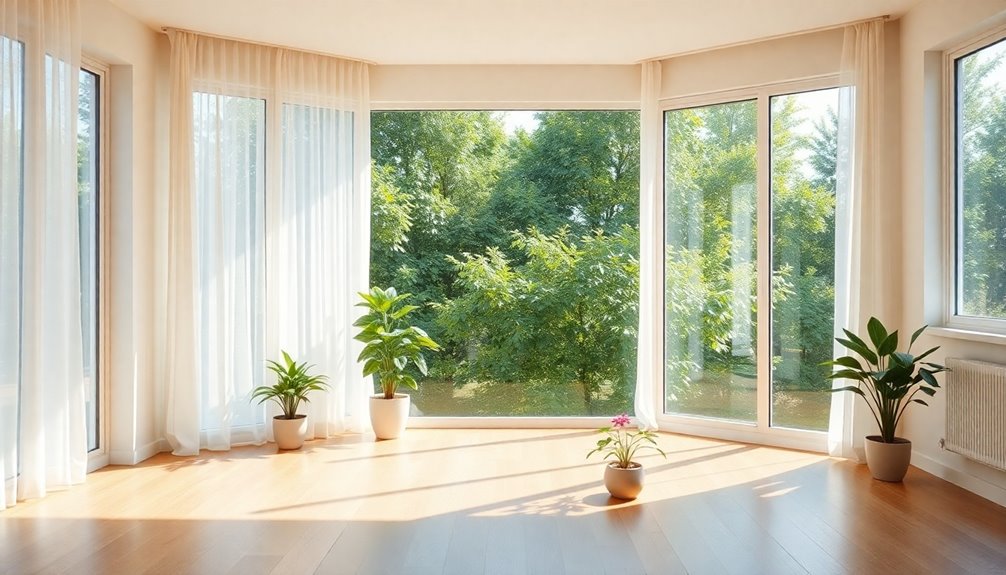
To effectively implement cross-ventilation, you’ll want to focus on an open layout design that allows air to flow freely throughout your space. Positioning windows and doors strategically can maximize airflow, creating a direct path for breezes to enter and exit. Additionally, incorporating heat pumps can further enhance energy efficiency by providing effective heating and cooling solutions that complement natural ventilation.
Open Layout Design
While designing an open layout, you can greatly enhance cross-ventilation by removing physical barriers that obstruct airflow. This design not only promotes natural ventilation but also increases energy efficiency.
Here are some strategies to contemplate:
- Minimize Walls: Create interconnected spaces for unimpeded airflow.
- Strategically Place Windows: Position openings to maximize pressure differentials.
- Reflect on Room Ratios: Optimize width-to-height ratios for better airflow.
- Use Doors Wisely: Guarantee that doors align with your ventilation strategy.
Implementing these elements can boost ventilation rates and reduce your reliance on mechanical cooling systems by up to 40%. Additionally, incorporating eco-friendly practices such as using natural materials in your home design can further enhance sustainability.
An effective open layout design can lead to significant energy savings, making your home more comfortable and environmentally friendly.
Strategic Opening Placement
When it comes to implementing cross-ventilation, the placement of openings is essential. You should strategically position at least two openings, like windows and vents, on opposing sides of your building design. This allows for effective air flow, facilitating cool air intake while warm air escapes.
Consider prevailing wind directions to enhance your natural ventilation systems, maximizing energy savings and improving indoor air quality. Aim for a width-to-height ratio of about 1:3 to enhance your openings’ effectiveness. Additionally, keep airflow paths clear of obstructions, such as large furniture or walls, to guarantee that air can move freely. Tools like Archistar can help analyze and refine your designs, guaranteeing optimal strategic opening placement for better cross ventilation outcomes. Incorporating water efficiency measures in your design can further contribute to sustainability and reduced utility costs.
Cross-Ventilation vs. Mechanical Ventilation: A Comparison
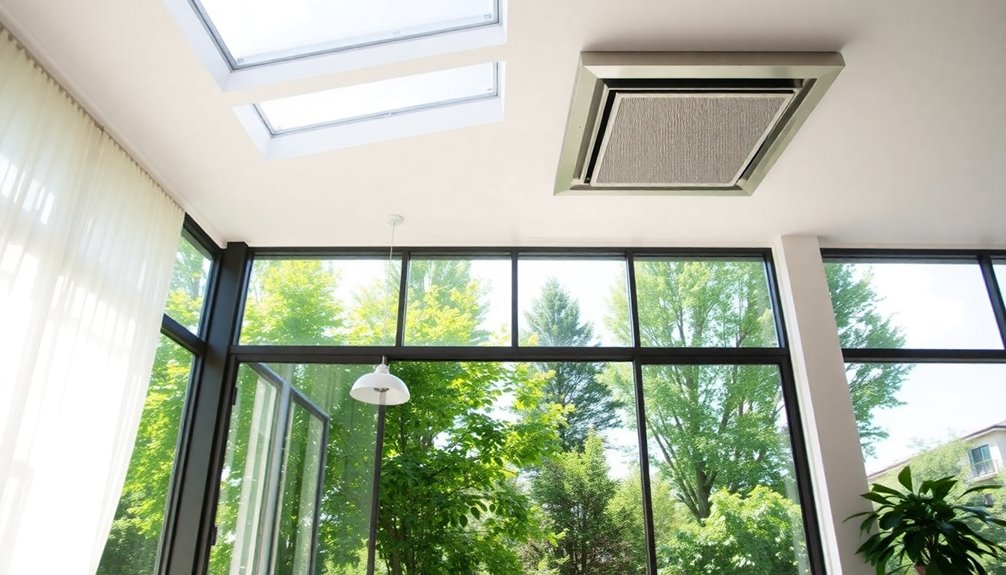
- Energy Savings: It can reduce energy consumption by 20%-40% compared to mechanical ventilation systems.
- Natural Airflow: Cross-ventilation utilizes natural airflow to cool indoor spaces, lowering temperatures by up to 1.5 °C.
- Indoor Air Quality: This method effectively flushes out stale air and pollutants, enhancing air quality without the risk of circulating contaminants.
- Sustainable Option: In rural or coastal areas, it promotes energy efficiency and reduces operational costs, making it a greener choice over mechanical systems. Additionally, heat pumps can further enhance the overall energy efficiency of homes when combined with cross-ventilation strategies.
Addressing Challenges in Achieving Cross-Ventilation

To achieve effective cross-ventilation, you’ll need to carefully consider the placement of openings in your home. Ideally, you should have at least two openings on opposite facades to facilitate ideal airflow.
Building orientation and external environmental factors, like wind direction and speed, are essential in this design approach. In urban areas, where airflow may be obstructed, incorporating courtyards or atriums can promote necessary air movement.
Additionally, using high-quality filters in your openings helps maintain indoor air quality by reducing pollutants and allergens. Furthermore, incorporating features such as heat pump systems can enhance overall ventilation and improve indoor air quality.
Innovations and Technologies Supporting Cross-Ventilation

While traditional design methods have focused on static ventilation solutions, modern innovations are revolutionizing how we achieve effective cross-ventilation in homes.
Here are some key advancements:
- Smart Building Technologies: IoT devices monitor and adjust ventilation in real-time, enhancing airflow management and indoor air quality.
- Advanced Simulation Software: Architects can model wind flow and air quality, designing spaces that maximize cross ventilation.
- Operable Windows: Adjustable windows allow for dynamic airflow, adapting to changing weather conditions.
- Integrated Facades: These designs optimize airflow while minimizing reliance on mechanical cooling systems.
With these innovations, you can enjoy energy savings of 20%-40%, considerably lowering heating and cooling costs while boosting your home’s energy efficiency.
Future Trends in Energy-Efficient Home Design

As energy efficiency becomes increasingly essential in home design, innovative strategies are emerging that seamlessly integrate cross ventilation with smart technologies. This trend focuses on using IoT devices for real-time adjustments, optimizing indoor air quality and thermal comfort. Advanced simulation software helps model airflow, improving energy performance predictions before construction.
Dynamic facades that respond to wind patterns enhance cross ventilation, promoting natural ventilation and maximizing energy savings. Green building certifications are pushing these strategies as part of sustainability criteria, encouraging energy-efficient practices.
| Trend | Benefits |
|---|---|
| Smart Building Technologies | Enhanced indoor air quality |
| Dynamic Facades | Improved cross ventilation |
| Simulation Software | Better energy performance |
| Natural Ventilation Strategies | Reduced reliance on cooling |
| Green Certifications | Encouraged sustainable design |
Frequently Asked Questions
What Is the Purpose of Cross Ventilation?
Cross ventilation’s purpose is to enhance indoor air quality and comfort.
By strategically placing openings like windows and vents, you create a pathway for fresh air to flow in while stale air exits. This natural airflow helps cool your space and reduces humidity, minimizing the risk of mold.
You’ll notice improved air circulation and a more pleasant living environment.
Plus, it can lead to significant energy savings by reducing reliance on mechanical cooling systems.
How Effective Is Cross Ventilation?
Cross ventilation’s effectiveness is impressive! It can lower indoor temperatures by around 1.5 °C, helping you feel cooler without relying on air conditioning.
When you strategically place openings, you can achieve ventilation rates much higher than traditional methods. This not only enhances airflow but also improves indoor air quality, reducing humidity and the risk of mold.
How Does Ventilation Affect Energy Efficiency?
Think of ventilation as your home’s breath. When it’s done right, it keeps the air fresh and cool, making your living space more comfortable without cranking up the AC.
Proper ventilation lowers indoor temperatures, reducing your need for energy-intensive cooling systems. You’ll notice lower utility bills and a smaller carbon footprint.
Do You Need Cross Ventilation?
You definitely need cross ventilation in your space.
It helps maintain fresh air flow, reducing your reliance on mechanical cooling systems, which can save you money on energy bills.
By allowing cooler outside air in and pushing stale air out, you can enhance indoor air quality and comfort.
Plus, it minimizes moisture buildup, lowering the risk of mold.
Conclusion
Incorporating cross-ventilation into your home design isn’t just eco-friendly; it can greatly lower your energy bills and improve indoor air quality. For instance, consider a family in a new eco-home who installed strategically placed windows and vents. They noticed a drastic reduction in their air conditioning usage during summer months, leading to savings that paid for their energy-efficient upgrades within just a few years. Embracing cross-ventilation can transform your living space into a healthier, cost-effective haven.
